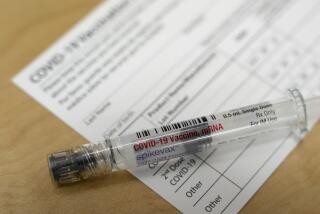Flu Shot Eligibility May Be Expanded
- Share via
Federal health authorities may broaden the range of people who can get a flu shot because of an unexpected quantity of unused vaccine.
The stocks exist because only about one-third of those who were encouraged to get a shot -- a high-risk group that includes the elderly, people with chronic medical conditions and healthcare workers who interact with patients -- have been vaccinated.
During last year’s flu season, 54% of high-risk people were vaccinated.
The Centers for Disease Control and Prevention said that its Advisory Committee on Immunization Practices would meet today to consider providing the shots to more people.
Much of the U.S. flu vaccine supply was lost when contamination was discovered in August at the Chiron Corp. production plant in Liverpool, England.
Two months of subsequent warnings about possible shortages, combined with a slow start to the flu season, discouraged some people from getting vaccinated, said Dr. Jonathan Fielding, Los Angeles County director of public health.
“If there isn’t very much flu, a lot of people think it wasn’t going to be a problem.... It’s human nature,” he said. “The critical message here is that it’s not too late.”
If the CDC expands the list of who should be vaccinated, it would follow moves adopted this week by the California Department of Health Services and Los Angeles County.
The new state and county guidelines encourage children ages 6 to 23 months to get the shot, as well as adults age 50 or older -- compared with the CDC standard of 65 and older.
Any healthy individual between 2 and 49 years old can obtain a flu vaccine nasal spray, available through major pharmacy chains.
Projected supplies would permit 65 million people to be vaccinated -- still below what is considered ideal.
How long stocks will last remains uncertain because “the demand for flu shots is very unpredictable,” said Norma Arceo, spokeswoman for the state Department of Health Services.
The worst part of the flu season typically is in February, she said.
About 1.2 million doses of the vaccine already have been distributed by the state, and more will be made available in January.
Nationwide, 41 states have sufficient supplies to vaccinate high-risk groups.
“We have no excess vaccine, but we do have places where private providers have not been able to use the supplies they ordered to meet the demands of their patient populations,” said CDC Director Dr. Julie Gerberding at a news conference Thursday.
The CDC is encouraging providers to return unused vaccines to state health departments for redistribution.
Arnold Monto, a vaccine expert at the University of Michigan, said he believed the CDC should enlarge the high-risk group so more people could be vaccinated.
But he added that “there was hardly a reason to panic” for those who were not in the high-risk group.
“The [infection] rate is about 10%, so nine out of 10 people will not get the virus anyway,” Monto said.
More to Read
Sign up for Essential California
The most important California stories and recommendations in your inbox every morning.
You may occasionally receive promotional content from the Los Angeles Times.










